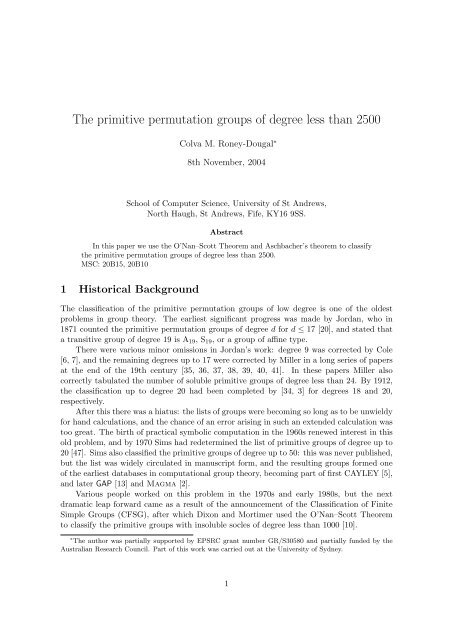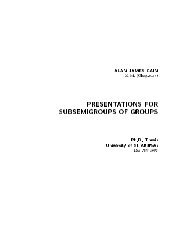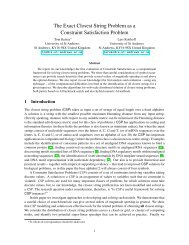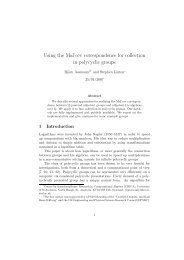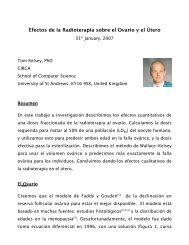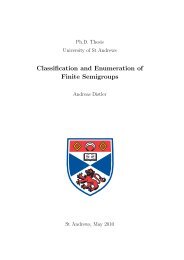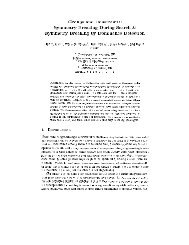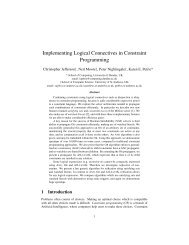The primitive permutation groups of degree less than 2500
The primitive permutation groups of degree less than 2500
The primitive permutation groups of degree less than 2500
Create successful ePaper yourself
Turn your PDF publications into a flip-book with our unique Google optimized e-Paper software.
stated two exceptions). We say that a subgroup <strong>of</strong> a classical group is AS-maximal if it isa maximal member <strong>of</strong> its Aschbacher class. See [22] for a considerably expanded statementand explanation <strong>of</strong> the theorem.We finish this section with some notation. Generally, we follow ATLAS [8] notationfor <strong>groups</strong>, thus D n is the dihedral group <strong>of</strong> order n. <strong>The</strong> letter p will always denote aprime, and the letter q := p e will be a prime power. We recall the exceptional isomorphismsA 5∼ = L2 (4) ∼ = L 2 (5), L 2 (7) ∼ = L 3 (2), A 6∼ = L2 (9), A 8∼ = L4 (2) and U 4 (2) ∼ = S 4 (3). Wewill consider each <strong>of</strong> these <strong>groups</strong> to be the first one listed here. <strong>The</strong> only point where wedivert from ATLAS notation is in our naming <strong>of</strong> the orthogonal <strong>groups</strong>, where PΩ ɛ (n, q),ɛ ∈ {+, −, ◦}, denotes a simple orthogonal group.3 Groups <strong>of</strong> Affine TypeIn this section we classify the <strong>primitive</strong> <strong>groups</strong> <strong>of</strong> affine type <strong>of</strong> <strong>degree</strong> d, for 1000 ≤ d < <strong>2500</strong>.Let V := F (n)p . <strong>The</strong> group AGL n (p) can be written as a split extension <strong>of</strong> a regularelementary abelian p-group <strong>of</strong> order p n , which we identify with V , and a point stabiliser,which we identify with GL n (p). If G ≤ AGL n (p) satisfies V ✂ G, then G is a group <strong>of</strong> affinetype. Under the map from the point stabiliser <strong>of</strong> AGL n (p) to GL n (p), the stabilisers <strong>of</strong><strong>primitive</strong> <strong>groups</strong> <strong>of</strong> affine type map to the irreducible sub<strong>groups</strong> <strong>of</strong> GL n (p).It is well–known that two irreducible sub<strong>groups</strong> <strong>of</strong> GL n (p) are conjugate if and only ifthe corresponding <strong>groups</strong> <strong>of</strong> affine type are conjugate in S p n. <strong>The</strong>refore the classification <strong>of</strong>the <strong>primitive</strong> <strong>groups</strong> <strong>of</strong> affine type <strong>of</strong> <strong>degree</strong> <strong>less</strong> <strong>than</strong> <strong>2500</strong> is equivalent to the classification<strong>of</strong> the irreducible sub<strong>groups</strong> <strong>of</strong> GL n (p) for p prime and p n < <strong>2500</strong>.<strong>The</strong> algorithm IrreducibleSub<strong>groups</strong> given in [45] returns the set <strong>of</strong> irreducible sub<strong>groups</strong><strong>of</strong> GL n (p), up to conjugacy in GL n (p). Determining conjugacy in the general lineargroup is the main computational hurdle: see [44] for details.As input to IrreducibleSub<strong>groups</strong> we require a list M <strong>of</strong> sub<strong>groups</strong> <strong>of</strong> GL n (p). Weuse Aschbacher’s theorem and other information to construct an initial list M that containsGL n (p) and all irreducible AS-maximal sub<strong>groups</strong> <strong>of</strong> GL n (p) that might be maximal. It doesnot matter if some are in fact not maximal. We then go through M and, for each group Gthat is not amenable, we find the irreducible maximal sub<strong>groups</strong> <strong>of</strong> G, and add to M thosethat are not known to be properly contained in an amenable subgroup <strong>of</strong> M. We iterate thisprocedure until all sub<strong>groups</strong> in M have been considered. We call a list M <strong>of</strong> sub<strong>groups</strong> <strong>of</strong>GL n (p) constructed via the above procedure a complete input list.<strong>The</strong> prime powers p n in the range 1000 ≤ p n < <strong>2500</strong> are as follows: p 2 for 37 ≤ p ≤ 47;p 3 for 11 ≤ p ≤ 13, 7 4 , 3 7 , 2 10 , 2 11 . It follows from the list <strong>of</strong> amenable <strong>groups</strong> in § 2 that weonly need to use the algorithms <strong>of</strong> [45] for the final three cases. We consider each <strong>of</strong> themseparately.Proposition 3.1 LetM := {GL 7 (3), SL 7 (3), ΓL 1 (3 7 ), N GL7 (3)(SO 7 (3)) = 2 × SO 7 (3)}.<strong>The</strong>n M is a complete input list for GL 7 (3).Pro<strong>of</strong>: We start by letting M := {GL 7 (3), SL 7 (3)}. We then use Aschbacher’s theorem t<strong>of</strong>ind the irreducible AS-maximal sub<strong>groups</strong> <strong>of</strong> GL 7 (3). <strong>The</strong> group GL 1 (3) ≀ S 7 preserves a5
We letM :={GL 10 (2), GL 5 (2) ≀ S 2 , ΓL 5 (2 2 ), ΓL 2 (2 5 ), Sp 10 (2), M 22 : 2 (2 copies),PGL 5 (2), ΣL 5 (2 2 ), GL 5 (2 2 ), SL 5 (2 2 ), N ΓL5 (2 2 )(GL 5 (2)), N ΓL5 (2 2 )(U 5 (2)),N ΓL5 (2 2 )(L 2 (11)), SO + 10 (2), SO− 10 (2), Ω+ 10 (2), L 5(2) : 2, Ω − 10 (2),S 12 , M 12 : 2}.Corollary 3.5 Let M be as above. <strong>The</strong>n M is a complete input list for GL 10 (2).Pro<strong>of</strong>: We construct a complete input list according to the above procedure. First we haveGL 10 (2) itself. It has no trivialities, so we start with the <strong>groups</strong> listed in Lemma 3.2.<strong>The</strong> first non–amenable group is ΓL 5 (4). We append all <strong>groups</strong> G such that SL 5 (4) ≤G < ΓL 5 (4) to M, then adjoin all <strong>of</strong> the other <strong>groups</strong> listed in Lemma 3.3, except forΓL 1 (2 10 ) ≤ ΓL 2 (2 5 ).<strong>The</strong> next non-amenable group is Sp 10 (2). It has no trivialities, and we adjoin to M all<strong>of</strong> its non-semilinear irreducible maximal sub<strong>groups</strong>, from Lemma 3.4.It follows from the pro<strong>of</strong> <strong>of</strong> Lemma 3.3 that each <strong>of</strong> the irreducible maximal sub<strong>groups</strong><strong>of</strong> ΣL 5 (4), GL 5 (4) and SL 5 (4) is either listed in M or is contained in an amenable element<strong>of</strong> M.<strong>The</strong> next non-amenable group is SO + 10 (2), whose irreducible maximal sub<strong>groups</strong> arelisted in the ATLAS (and corrected in [19]). Next we find SO − 10 (2), and append those <strong>of</strong>its irreducible maximal sub<strong>groups</strong> that are not obviously contained in an amenable member<strong>of</strong> M. <strong>The</strong> group Ω + 10 (2) has no irreducible maximal sub<strong>groups</strong>, and with the exception <strong>of</strong>M 12 : 2, the irreducible maximal sub<strong>groups</strong> <strong>of</strong> Ω − 10 (2) are contained in S 12, (3 × U 5 (2)) : 2 orGL 2 (5) ≀ S 2 .✷Proposition 3.6 Let M := {GL 11 (2), ΓL 1 (2 11 ), M 24 (2 copies)}. <strong>The</strong>n M is a completeinput list for GL 11 (2).Pro<strong>of</strong>: We start by finding the maximal irreducible sub<strong>groups</strong> <strong>of</strong> GL 11 (2). <strong>The</strong> im<strong>primitive</strong>group GL 1 (2) ≀ S 11 is reducible, and hence nonmaximal. <strong>The</strong> unique AS-maximal superfieldgroup is in M. <strong>The</strong>re are no C 4 or C 7 <strong>groups</strong> since 11 is prime. <strong>The</strong>re are no C 5 <strong>groups</strong> since2 is prime. <strong>The</strong>re are no C 6 <strong>groups</strong> since 11 does not divide 2 − 1. <strong>The</strong>re are no classical<strong>groups</strong> since SO 11 (2) is reducible.We consult [16, 32] to find that M 23 and M 24 are the only C 9 <strong>groups</strong>. <strong>The</strong> subgroup<strong>of</strong> M 24 that is isomorphic to M 23 is acting irreducibly in this representation, we we appendonly M 24 to M.Since all <strong>of</strong> the irreducible maximal sub<strong>groups</strong> <strong>of</strong> GL 11 (2) are amenable, we are done. ✷Given the complete input lists given in Proposition 3.1, Corollary 3.5 and Proposition 3.6,we can use them as input to the algorithms presented in [45] to compute the irreduciblesub<strong>groups</strong> <strong>of</strong> GL 7 (3), GL 10 (2) and GL 11 (2) respectively. Thus the affine <strong>primitive</strong> <strong>groups</strong> <strong>of</strong><strong>degree</strong> <strong>less</strong> <strong>than</strong> <strong>2500</strong> are known. <strong>The</strong> results are given in Table 7.4 Almost Simple GroupsIn this section we classify the almost simple <strong>primitive</strong> <strong>groups</strong> <strong>of</strong> <strong>degree</strong> <strong>less</strong> <strong>than</strong> <strong>2500</strong>. This isa three stage process. In subsection 4.1 we determine the simple <strong>groups</strong> that have an action7
<strong>of</strong> <strong>degree</strong> <strong>less</strong> <strong>than</strong> <strong>2500</strong>. For the alternating <strong>groups</strong> we determine which <strong>groups</strong> only haveactions on the cosets <strong>of</strong> intransitive sub<strong>groups</strong>, and for the classical <strong>groups</strong> we determine insubsection 4.2 which <strong>groups</strong> only have actions on the cosets <strong>of</strong> reducible sub<strong>groups</strong>. Finally,we discuss on an individual basis the <strong>groups</strong> which have at least one action <strong>of</strong> <strong>degree</strong> <strong>less</strong><strong>than</strong> <strong>2500</strong>, that is on the cosets <strong>of</strong> an irreducible subgroup, provided that these <strong>groups</strong> areneither described in the ATLAS nor amenable. Note that the results <strong>of</strong> this section re-checkthose <strong>of</strong> [10].Let G be an almost simple group. By P (G) we denote the minimal integer d such thatG has a faithful <strong>primitive</strong> <strong>permutation</strong> action <strong>of</strong> <strong>degree</strong> d.Lemma 4.1 Let G be an almost simple group with socle S, and suppose that S < G ≤Aut(S). <strong>The</strong>n P (G) ≥ P (S).Pro<strong>of</strong>: Let H ≤ G be the point stabiliser in a <strong>primitive</strong> faithful action for G <strong>of</strong> <strong>degree</strong>P (G). Since the action <strong>of</strong> G is faithful, H must be core-free, and so in particular S ≰ H.<strong>The</strong> <strong>degree</strong> <strong>of</strong> the action is [G : H] = [S : (S ∩ H)], so if H ∩ S is maximal in S thenP (G) = P (S), otherwise P (G) > P (S).✷4.1 <strong>The</strong> determination <strong>of</strong> soclesIn this subsection we consider each <strong>of</strong> the families <strong>of</strong> simple <strong>groups</strong> in turn, and establishwhich <strong>of</strong> these <strong>groups</strong> could be the socle <strong>of</strong> a <strong>primitive</strong> almost simple group <strong>of</strong> <strong>degree</strong> <strong>less</strong><strong>than</strong> <strong>2500</strong>.Proposition 4.2 If A n or S n has a faithful <strong>primitive</strong> action, other <strong>than</strong> the natural action,<strong>of</strong> <strong>degree</strong> <strong>less</strong> <strong>than</strong> <strong>2500</strong>, then n ≤ 71. If H, the point stabiliser in this action, is transitiveon {1, . . . , n}, then n ≤ 14. If H acts <strong>primitive</strong>ly on {1, . . . , n}, then n ≤ 12.Pro<strong>of</strong>: Let X = A n , and assume that n ≥ 7. Let X 0 ≠ A n−1 be a proper subgroup <strong>of</strong> X,and assume that X 0 is either a point stabiliser in a <strong>primitive</strong> action <strong>of</strong> A n on a set S <strong>of</strong> size<strong>less</strong> <strong>than</strong> <strong>2500</strong>, or that X 0 = Y 0 ∩ A n , where Y 0 is a point stabiliser in a <strong>primitive</strong> action <strong>of</strong>S n on S.We will prove the lemma by examining the action <strong>of</strong> X 0 on {1, . . . , n}. If X 0 has anorbit <strong>of</strong> length 1 then X 0 is conjugate to a subgroup <strong>of</strong> A n−1 . If the almost simple groupis A n then since X 0 ≤ max X we must have X 0∼ = An−1 , and hence the action is the naturalaction, a contradiction. If X 0 = Y 0 ∩ A n then, since [Y 0 : X 0 ] = 2, the group Y 0 must haveeither 0 or 1 orbits <strong>of</strong> length 1. If Y 0 has a single orbit <strong>of</strong> length 1 then, by maximality <strong>of</strong> Y 0in S n , we get Y 0∼ = Sn−1 , a contradiction. If Y 0 has no orbits <strong>of</strong> length 1 then Y 0∼ = S2 × S n−2 .But then X 0 has no fixed points, a contradiction.Suppose that X 0 is <strong>primitive</strong> in its action on {1, . . . , n}. By Bochert’s <strong>The</strong>orem [18,Section 14.2], the index |S n : X 0 | > ⌊(n + 1)/2⌋! so, since |A n : X 0 | < <strong>2500</strong>, we have|S n : X 0 | < 4999, so n ≤ 12.Next suppose that X 0 is transitive but im<strong>primitive</strong> in its action on {1, . . . , n}. If X 0has a block <strong>of</strong> size d, and m := n/d, then X 0 can be embedded in (S d ≀ S m ) ∩ A n . Thus|X 0 | ≤ (d!) m (m!)/2. <strong>The</strong>refore|A n : X 0 | ≥ f(m, d) = (md)!/((d!) m m!).8
Table 1: Socles <strong>of</strong> <strong>primitive</strong> <strong>groups</strong> <strong>of</strong> <strong>degree</strong> <strong>less</strong> <strong>than</strong> <strong>2500</strong>Not in ATLAS andGroup n q not amenableL n (q) n = 2 7 ≤ q ≤ 2499n = 3 3 ≤ q ≤ 47n = 4 3 ≤ q ≤ 13n = 5 2 ≤ q ≤ 5 q = 4n = 6 2 ≤ q ≤ 4 q = 3, 4n = 7 2 ≤ q ≤ 3 q = 3L n (2) 8 ≤ n ≤ 11 10 ≤ n ≤ 11U n (q) n = 3 3 ≤ q ≤ 13n = 4 2 ≤ q ≤ 5 q = 4, 5n = 5 2 ≤ q ≤ 3 q = 3n = 6 q = 2S n (q) n = 4 4 ≤ q ≤ 13 q = 8, 9n = 6 2 ≤ q ≤ 4 q = 48 ≤ n ≤ 12 q = 2 n = 10, 12PΩ n (q) n = 7 q = 3PΩ + n (q) n = 8 2 ≤ q ≤ 310 ≤ n ≤ 12 q = 2 n = 12PΩ − n (q) n = 8 2 ≤ q ≤ 310 ≤ n ≤ 12 q = 2 n = 12Since f(m, d) increases monotonically in both variables and f(2, 8) = 6435, f(3, 4) = 5775,f(4, 3) = 15400, f(6, 2) = 10395, we conclude that |A n : X 0 | > <strong>2500</strong> whenever n = md > 14.Finally, suppose that X 0 is intransitive in its action on {1, . . . , n}, but has no orbit <strong>of</strong>length 1. Let Γ be the smallest orbit <strong>of</strong> X 0 , and suppose that |Γ| = k. <strong>The</strong>n X 0 ≤ (S k ×S n−k ),so |X 0 | < k!(n − k)!/2, and( ( n n|A n : X 0 | > n!/(k!(n − k)!) = ≥ .k)2)<strong>The</strong>refore, n ≤ 71.✷Proposition 4.3 Let G be an almost simple classical group with a faithful <strong>primitive</strong> <strong>permutation</strong>action <strong>of</strong> <strong>degree</strong> <strong>less</strong> <strong>than</strong> <strong>2500</strong>. <strong>The</strong>n the socle S <strong>of</strong> G appears in Table 4.1.Pro<strong>of</strong>: By Lemma 4.1 it suffices to consider the simple classical <strong>groups</strong>. <strong>The</strong> result foreach <strong>of</strong> them follows from [22, Table 5.2.A]: we will however discuss each case individually,for the sake <strong>of</strong> clarity.In the linear case, for (n, q) ∉ {(2, 5), (2, 7), (2, 9), (2, 11), (4, 2)} we have P (L n (q)) =(q n − 1)/(q − 1). <strong>The</strong> exceptions all have representations <strong>of</strong> <strong>degree</strong> <strong>less</strong> <strong>than</strong> <strong>2500</strong>.In the unitary case, for q ≠ 5 we have P (U 3 (q)) = q 3 + 1; whilst P (U 3 (5)) = 50. Wehave P (U 4 (q)) = (q + 1)(q 3 + 1). For n ≥ 5P (U n (q)) = (q n − (−1) n )(q n−1 − (−1) n−1 )/(q 2 − 1),9
is not simple. Its socle, 2 F 4 (2) ′ , is described in the ATLAS: it has maximal sub<strong>groups</strong> <strong>of</strong>index <strong>less</strong> <strong>than</strong> <strong>2500</strong>.Finally, we have that the minimal <strong>degree</strong> <strong>of</strong> a projective representation <strong>of</strong> 2 G 2 (3 1+2m ) =R(3 1+2m ) is 3 1+2m (3 1+2m − 1) [28]. We require m > 0 as 2 G 2 (3) = L 2 (8) : 3. This leavesonly 2 G 2 (3 3 ), which is described in the ATLAS: it has no sub<strong>groups</strong> <strong>of</strong> index <strong>less</strong> <strong>than</strong> <strong>2500</strong>.✷<strong>The</strong> maximal sub<strong>groups</strong> <strong>of</strong> all sporadic <strong>groups</strong> S for which P (S) < <strong>2500</strong> are describedin the ATLAS.4.2 Reduction <strong>of</strong> actionsProposition 4.5 Let G be an almost simple group <strong>of</strong> Lie type and suppose that (a) G hasa <strong>primitive</strong> <strong>permutation</strong> action <strong>of</strong> <strong>degree</strong> <strong>less</strong> <strong>than</strong> <strong>2500</strong>, and (b) G is not described in theATLAS. <strong>The</strong>n the point stabiliser <strong>of</strong> G is reducible un<strong>less</strong> the socle <strong>of</strong> G is one <strong>of</strong>: L 2 (p)for 37 ≤ p ≤ 71, L 2 (p 2 ) for 7 ≤ p ≤ 17, L 2 (p e ) for e ≥ 3 and p e ∈ {32, 64, 81}, L 4 (q) for4 ≤ q ≤ 5, U 4 (4), U 6 (2), S 4 (q) for 5 ≤ q ≤ 8, S 6 (4), S 10 (2) or S 12 (2).Pro<strong>of</strong>: We discuss only the nonamenable <strong>groups</strong>.Suppose that the socle <strong>of</strong> G is L 5 (q), for some q with 3 ≤ q ≤ 5. If q is odd then thelargest irreducible maximal subgroup <strong>of</strong> G is almost simple with socle Ω 5 (q) [30, Thm 5.1].We have N L5 (q)(Ω 5 (q)) = SO 5 (q), and for q > 3 we have [L 5 (q) : SO 5 (q)] > <strong>2500</strong>. It followsfrom [30, Thm 5.1] that the largest irreducible subgroup <strong>of</strong> L 5 (4) is U 5 (2), which has indexgreater <strong>than</strong> <strong>2500</strong>.Suppose that the socle <strong>of</strong> G is L d (q) with d > 5 even and q ≤ 4. <strong>The</strong> largest irreduciblemaximal subgroup <strong>of</strong> G is N G (S d (q)) ≤ PGSp d (q) [30, Thm 5.1]. In each case this has indexgreater <strong>than</strong> <strong>2500</strong>.Now suppose that the socle <strong>of</strong> G is L n (2) with n ∈ {7, 9, 11}. If n = 9, 11 then themaximal irreducible sub<strong>groups</strong> <strong>of</strong> G have index greater <strong>than</strong> 2 (n−2)(n−3)/2 > <strong>2500</strong> [21, Thm1]. If n = 7 then the largest irreducible maximal subgroup <strong>of</strong> G has order <strong>less</strong> <strong>than</strong> 2 18 [30,Thm 5.1], and hence index greater <strong>than</strong> <strong>2500</strong>.We complete the linear case by supposing that G is L 7 (3). <strong>The</strong>n [21, Thm 1] states thatthe largest irreducible maximal subgroup <strong>of</strong> G has index at least 3 15 .We consider the unitary case next. <strong>The</strong> largest irreducible subgroup <strong>of</strong> U 4 (5) is S 4 (5) [30,Thm 5.3], which has index 3150. <strong>The</strong> largest irreducible subgroup <strong>of</strong> U 5 (3) is N U5 (3)(Ω 5 (3)) =SO 5 (3) [30, Thm 5.3], which has index greater <strong>than</strong> <strong>2500</strong>.<strong>The</strong>orem 5.2 <strong>of</strong> [30] states that the largest irreducible subgroup <strong>of</strong> S 4 (9) is L 2 (81).2,which has index greater <strong>than</strong> <strong>2500</strong>.Finally, we consider the orthogonal <strong>groups</strong>. <strong>The</strong> largest irreducible maximal subgroup<strong>of</strong> a group with socle PΩ ɛ 12 (2) is N G(GU 6 (2).2) in type + and A 13 in type − [30, Thm 5.4+ discussion] . Each <strong>of</strong> these has index greater <strong>than</strong> <strong>2500</strong>. ✷Proposition 4.6 Let G be a <strong>primitive</strong> almost simple classical group <strong>of</strong> <strong>degree</strong> <strong>less</strong> <strong>than</strong> <strong>2500</strong>.If G is not described in the ATLAS, is not amenable, and all faithful <strong>primitive</strong> <strong>permutation</strong>actions <strong>of</strong> G <strong>of</strong> <strong>degree</strong> <strong>less</strong> <strong>than</strong> <strong>2500</strong> are on the cosets <strong>of</strong> reducible sub<strong>groups</strong>, then the<strong>primitive</strong> <strong>permutation</strong> representations <strong>of</strong> G are as described in § 7.11
Pro<strong>of</strong>: Let G be a group satisfying the hypotheses <strong>of</strong> the proposition. <strong>The</strong>n the socle <strong>of</strong> Gis one <strong>of</strong>L 5 (4), L 6 (3), L 6 (4), L 7 (3), L 9 (2), L 10 (2), L 11 (2), U 4 (5), S 4 (9), PΩ ɛ 12(2).For each <strong>of</strong> the above <strong>groups</strong> L n (q) we use the algorithms <strong>of</strong> [17] to construct the k-space stabiliserfor 1 ≤ k ≤ d/2 and, if the corresponding <strong>permutation</strong> representation has <strong>degree</strong> <strong>less</strong><strong>than</strong> <strong>2500</strong>, we insert the corresponding <strong>permutation</strong> representation, with normaliser PΓL n (q).We use [17] to construct the novelty maximals <strong>of</strong> L2 n (q), which extend to PΓL 2 n (q), andinclude these as appropriate.In the unitary case, we use [17] to construct the stabiliser <strong>of</strong> an isotropic point, a nonisotropicpoint, and an isotropic 2-space. Only the action on the cosets <strong>of</strong> the first <strong>of</strong> thesehas <strong>degree</strong> <strong>less</strong> <strong>than</strong> <strong>2500</strong>: this action extends to PΓU 4 (5).In a symplectic geometry all points are isotropic, so we use [17] to construct the stabiliser<strong>of</strong> a point and a totally isotropic 2-space. Both <strong>of</strong> these have index <strong>less</strong> <strong>than</strong> <strong>2500</strong>, and thecorresponding <strong>permutation</strong> action extends to the full automorphism group.Finally, in the orthogonal cases we find that the stabilisers <strong>of</strong> an isotropic and <strong>of</strong> anonisotropic point have indices <strong>less</strong> <strong>than</strong> <strong>2500</strong>, but that the stabilisers <strong>of</strong> any larger subspaceshave indices greater <strong>than</strong> <strong>2500</strong>. <strong>The</strong> point stabilisers extend to maximal sub<strong>groups</strong><strong>of</strong> Aut(PΩ ɛ 12 (2)) = PSOɛ 12(2).✷Corollary 4.7 Let G be an almost simple <strong>primitive</strong> group <strong>of</strong> <strong>degree</strong> <strong>less</strong> <strong>than</strong> <strong>2500</strong>. If G isnot a classical group acting on the cosets <strong>of</strong> a reducible subgroup, then either G is describedin the ATLAS, or G is amenable, or the socle <strong>of</strong> G is one <strong>of</strong>: U 4 (4), U 6 (2), S 4 (8), S 6 (4),S 10 (2), S 12 (2).Proposition 4.8 If G is a group whose socle is one <strong>of</strong> the exceptions listed in the previouscorollary, then the faithful <strong>primitive</strong> <strong>permutation</strong> actions <strong>of</strong> G are as described in §7.Pro<strong>of</strong>: First we examine U 4 (4). <strong>The</strong> C 2 AS-maximals have index greater <strong>than</strong> <strong>2500</strong>. <strong>The</strong>reare no AS-maximals in C 3 , C 4 , C 6 , C 7 or C 8 . <strong>The</strong> unique AS-maximal subfield group isN U4 (4)(S 4 (4)) = S 4 (4), <strong>of</strong> index 1040. Consultation <strong>of</strong> [16, 32] shows that there are nomaximal C 9 <strong>groups</strong>. Thus the only entries in Table 5 are on cosets <strong>of</strong> reducible or symplecticsub<strong>groups</strong>.Next we discuss U 6 (2). <strong>The</strong> indices <strong>of</strong> all geometric irreducible AS-maximals are greater<strong>than</strong> <strong>2500</strong>. Consulting [16] we find the following candidates for maximal C 9 <strong>groups</strong>: A 7 , M 22and U 4 (3). <strong>The</strong> normalisers <strong>of</strong> the first two <strong>of</strong> these have index greater <strong>than</strong> <strong>2500</strong> in U 6 (2),the normaliser <strong>of</strong> the third has index 1048. Consulting [32] we find L 3 (2).2 which preservesan orthogonal form, L 3 (4).2 which has index greater <strong>than</strong> <strong>2500</strong>, L 4 (2) which is a subgroup<strong>of</strong> L 6 (2), U 4 (2) which preserves a quadratic form, S 6 (2) which is a subfield group, and G 2 (2)which preserves a symplectic form. Thus the only entries in Table 5 are on cosets <strong>of</strong> reducible<strong>groups</strong>, or on the cosets <strong>of</strong> N U6 (2)(U 4 (3)).We move on now to the symplectic <strong>groups</strong>. <strong>The</strong> first group which we must consideris S 4 (8). <strong>The</strong> symplectic <strong>groups</strong> in dimension 4 and characteristic 2 have an exceptionalouter automorphism, and hence have a different maximal subgroup structure from the othersymplectic <strong>groups</strong>, see [1] for details. <strong>The</strong> maximal im<strong>primitive</strong> group Sp 2 (8) ≀ S 2 has index2080, and is conjugate in Aut(S 4 (8)) to PSO + 4 (8). <strong>The</strong> maximal superfield group has index2016 and is conjugate in Aut(S 4 (8)) to PSO − 4 (8). <strong>The</strong> maximal subfield group has index12
greater <strong>than</strong> <strong>2500</strong>. <strong>The</strong> largest C 9 group is Sz(8), but it has index greater <strong>than</strong> <strong>2500</strong> inS 4 (8). <strong>The</strong>re are assorted novelty maximal sub<strong>groups</strong> <strong>of</strong> S 4 (8).2 (graph automorphism) but,since they must have index at least 2 in the maximal sub<strong>groups</strong> <strong>of</strong> S 4 (8), we need onlyconsider the novelty reducible. However, this has index 5265.<strong>The</strong> next symplectic group on our list is S 6 (4). <strong>The</strong> C 2 , C 3 and C 5 AS-maximals all haveindices greater <strong>than</strong> <strong>2500</strong>. It is shown in [22] that C 4 <strong>groups</strong> are nonmaximal in symplectic<strong>groups</strong> for even q. <strong>The</strong> classical <strong>groups</strong> PSO + 6 (4) ∼ = L 4 (4) : 2 and PSO − 6 (4) ∼ = U 4 (4) : 2have indices 2080 and 2016 respectively, and hence are shown in §7. From [16] we seethat U 3 (3), J 2 and L 2 (13) might be maximal C 9 sub<strong>groups</strong> <strong>of</strong> S 6 (4), but all <strong>of</strong> these haveindex greater <strong>than</strong> <strong>2500</strong>. From [32] we see that L 3 (4), U 3 (4) and G 2 (4) are potentiallymaximal. Of these, L 3 (4) has no symplectic representations, G 2 (4) has index 16320 in S 6 (4)and |S 6 (4)|/| PΓU 3 (4)| > <strong>2500</strong>.Now we turn to Sp 10 (2). It follows from the main theorem <strong>of</strong> [30] that the irreduciblemaximal sub<strong>groups</strong> <strong>of</strong> Sp 10 (2) are geometric, or have socle A n for n = 11, 12. <strong>The</strong> ASmaximalim<strong>primitive</strong> sub<strong>groups</strong> <strong>of</strong> Sp 10 (2) have index greater <strong>than</strong> <strong>2500</strong>, as does the ASmaximalsuperfield subgroup. <strong>The</strong> classical <strong>groups</strong> PSO + 10 (2) and PSO− 10 (2) have indices528 and 426 respectively. <strong>The</strong> remaining geometric Aschbacher classes are empty. Since| Sp 10 (2)|/12! > <strong>2500</strong> the results in Table 6 follow.Finally we turn to Sp 12 (2). Similarly to the previous case, the im<strong>primitive</strong> and semilinearAS-maximals have index greater <strong>than</strong> <strong>2500</strong>, and there are no <strong>groups</strong> in class C i for 4 ≤ i ≤ 7.In C 8 we find PSO + 12 (2) and PSO− 12 (2), <strong>of</strong> indices 2080 and 2016 respectively. It follows from[30] that there are no C 9 <strong>groups</strong> <strong>of</strong> index <strong>less</strong> <strong>than</strong> | Sp 12 (2)|/14! > <strong>2500</strong>. ✷Thus the almost simple <strong>primitive</strong> <strong>groups</strong> <strong>of</strong> <strong>degree</strong> <strong>less</strong> <strong>than</strong> <strong>2500</strong> are known.5 Nonabelian composite socles<strong>The</strong> final possibility for the socle <strong>of</strong> a finite <strong>primitive</strong> <strong>permutation</strong> group is that it is nonabelianand not simple. <strong>The</strong>re are three types <strong>of</strong> <strong>groups</strong> that fall into this category: twistedwreath product <strong>groups</strong>, product action <strong>groups</strong> and diagonal action <strong>groups</strong>. In this sectionwe classify the <strong>primitive</strong> <strong>groups</strong> with nonabelian composite socles <strong>of</strong> <strong>degree</strong> <strong>less</strong> <strong>than</strong> <strong>2500</strong>.For the twisted wreath product <strong>groups</strong>, it follows immediately from the statement <strong>of</strong> theO’Nan–Scott <strong>The</strong>orem that the <strong>degree</strong> <strong>of</strong> any group with twisted wreath product action isat least 60 6 .If G is a group <strong>of</strong> product action type then we may denote the socle <strong>of</strong> G by K m , whereK is the socle <strong>of</strong> a <strong>primitive</strong> <strong>permutation</strong> group U <strong>of</strong> <strong>degree</strong> n <strong>of</strong> almost simple or diagonaltype. <strong>The</strong> <strong>degree</strong> <strong>of</strong> G is n m and it follows from [10, Lemma 5] that K m ≤ G ≤ N Sn (U) ≀ S m .Since we are assuming that n m < <strong>2500</strong>, only restricted values <strong>of</strong> n and m may occur. Inparticular, since 60 2 > <strong>2500</strong>, U must be almost simple, and so K is a nonabelian simplegroup. <strong>The</strong> <strong>degree</strong> n <strong>of</strong> U is therefore at least 5, so m ≤ 4. If m = 2 then n ≤ 49; if m = 3then n ≤ 13; and if m = 4 then n ≤ 7.Our strategy to construct the <strong>groups</strong> is computational. We make extensive use <strong>of</strong> thefact that the <strong>primitive</strong> <strong>groups</strong> <strong>of</strong> <strong>degree</strong> <strong>less</strong> <strong>than</strong> 50 are well-known.For 2 ≤ m ≤ 4, and 5 ≤ n ≤ m√ <strong>2500</strong> do1. For each <strong>primitive</strong> almost simple group U <strong>of</strong> <strong>degree</strong> n that is maximal in its cohort do:(a) Let M := U ≀ S m , with the product action.13
(b) Let Q := M/Soc(M).(c) For each subgroup S <strong>of</strong> Q (up to Q-conjugacy) doi. If the preimage S ′ <strong>of</strong> S in M is <strong>primitive</strong>, add S ′ to the list <strong>of</strong> <strong>primitive</strong>product action <strong>groups</strong> <strong>of</strong> <strong>degree</strong> n m .It is clear that if two <strong>groups</strong> are conjugate in Q then their preimages are conjugate in M.We discuss our techniques for checking that all <strong>groups</strong> in the tables are pairwise inconjugatein the symmetric group in §6. <strong>The</strong> results are given in Tables 10 and 11.Finally, we construct the diagonal action <strong>groups</strong>. Since 60 2 > <strong>2500</strong>, we need only consider<strong>groups</strong> with two factors in the socle. <strong>The</strong> simple <strong>groups</strong> <strong>of</strong> order <strong>less</strong> <strong>than</strong> <strong>2500</strong> areA 5 , L 3 (2), A 6 , L 2 (8), L 2 (11), L 2 (13), and L 2 (17).For each <strong>of</strong> these <strong>groups</strong>, we proceed as follows:1. Let M := Aut(T ) ≀ S 2 .2. For each G ≤ M with |M : N| = | Out(T )| do:(a) If G has a maximal subgroup K <strong>of</strong> index |T |, construct the <strong>primitive</strong> <strong>permutation</strong>action <strong>of</strong> G on K.(b) Return the list <strong>of</strong> <strong>primitive</strong> <strong>groups</strong> H such that Soc(G) = T 2 ≤ H ≤ G.If two <strong>groups</strong> are conjugate in G, then they are conjugate in the symmetric group. Wediscuss how we double–checked the converse in the next section. <strong>The</strong>re are only two cohorts<strong>of</strong> <strong>groups</strong> <strong>of</strong> <strong>degree</strong> greater <strong>than</strong> 1000: those with socle L 2 (13) × L 2 (13) and those with socleL 2 (17) × L 2 (17). <strong>The</strong>y are described in the discussion at the beginning <strong>of</strong> Section 7.6 AccuracyIn this section we describe the various checks that were applied to our data, and give anexplicit list <strong>of</strong> which results <strong>of</strong> other people have been assumed as true without rechecking.<strong>The</strong>re are three main types <strong>of</strong> errors which we wish to eliminate: mathematical, computational,and what we will term clerical, namely those errors that result from processing largeamounts <strong>of</strong> data into complex tables. We will first discuss the most general checks that wereapplied, before considering each <strong>of</strong> the three types <strong>of</strong> error in turn.<strong>The</strong> <strong>primitive</strong> <strong>groups</strong> <strong>of</strong> <strong>degree</strong> <strong>less</strong> <strong>than</strong> 1000 were compared with the lists in [10], ascorrected in [45]. This showed that we have found one additional cohort <strong>of</strong> <strong>primitive</strong> <strong>groups</strong>,an action <strong>of</strong> L 2 (41) on the cosets <strong>of</strong> A 5 , as well as rediscovering various previously-knownerrors, mostly concerning the rank <strong>of</strong> the normaliser.<strong>The</strong> numbers <strong>of</strong> <strong>primitive</strong> soluble <strong>groups</strong> were compared with the lists in [12]. Ournumbers agreed in all cases with theirs.Within each <strong>degree</strong>, all <strong>groups</strong> were checked to be pairwise inconjugate. To do this weused the techniques <strong>of</strong> [45]. First we computed, for each group G, a signature consisting <strong>of</strong>|G|, the transitivity k <strong>of</strong> G, the multiset <strong>of</strong> orbit lengths <strong>of</strong> the k-point stabiliser, the multiset<strong>of</strong> chief factors <strong>of</strong> G, and the orders <strong>of</strong> all <strong>groups</strong> in the derived series <strong>of</strong> G. <strong>The</strong> <strong>groups</strong> wereput into equivalence classes by signature, and those in classes <strong>of</strong> size one were discarded.14
We then computed the Sylow 2-subgroup <strong>of</strong> each remaining group, and partitionedthe <strong>groups</strong> yet further using their extended signature: the signature extended by an extracoordinate containing the multisets <strong>of</strong> isomorphism types <strong>of</strong> all abelian <strong>groups</strong> <strong>of</strong> ordernot divisible by 512 that occur as quotients in the derived series <strong>of</strong> G. Again, <strong>groups</strong> inequivalence classes <strong>of</strong> size 1 were discarded.Next, we computed the point stabiliser and the derived subgroup <strong>of</strong> each remaininggroup, and partitioned each class yet further by the extended signature <strong>of</strong> each <strong>of</strong> these<strong>groups</strong> group. Very few <strong>groups</strong> remained after this procedure, and none were in equivalenceclasses <strong>of</strong> size greater <strong>than</strong> 2. We simply checked that each pair <strong>of</strong> <strong>groups</strong> were nonisomorphic.As far as other sources <strong>of</strong> information are concerned, we assumed all that <strong>of</strong> the resultscited in Propositions 4.3, 4.4 and 4.5 were correct. We have assumed the accuracy <strong>of</strong> [32] and<strong>of</strong> the corrected version <strong>of</strong> [16]. When using the ATLAS, we have checked the current version<strong>of</strong> Norton’s “Improvements to the Atlas”, from http://web.mat.bham.ac.uk/atlas/v2.0/.We have obviously made extensive use <strong>of</strong> [1], [19] and [22].Next we consider the computational accuracy. <strong>The</strong> most basic test was to re-run all <strong>of</strong>the code several times, <strong>of</strong>ten with minor adjustments to the actual coding, and to check thatthe results agreed. <strong>The</strong> algorithms <strong>of</strong> [17] were used to make many <strong>of</strong> the geometric maximalsub<strong>groups</strong>: each time we did this we checked that the <strong>groups</strong> constructed were equal to theirown normalisers. <strong>The</strong> code for the amenable <strong>groups</strong> has now been in Magma for at least ayear: the fact that it is in regular use by many people, and that no bugs have been foundafter the initial period, gives us a reasonable <strong>degree</strong> <strong>of</strong> confidence that the implementationis reliable. We also performed various <strong>of</strong> our calculations with almost simple <strong>groups</strong> in GAPas well.We finish with a discussion <strong>of</strong> the clerical checks. Firstly, we have repeatedly examinedthe tables, comparing descriptions with those in the ATLAS, and ensuring that the content<strong>of</strong> the tables matches the descriptions in the relevant section <strong>of</strong> the paper. Since the <strong>groups</strong>that we have constructed are to go into a database, we have electronic files <strong>of</strong> all <strong>of</strong> them,and have checked that the totals from the paper copy agree with the files. For all <strong>of</strong> theamenable <strong>groups</strong>, a Magma run was done to print out the <strong>degree</strong>s <strong>of</strong> the <strong>primitive</strong> actions,and the number <strong>of</strong> <strong>groups</strong> in each cohort. This was then compared with the typeset version.7 <strong>The</strong> TablesIn this section we give the tables describing the <strong>primitive</strong> <strong>groups</strong> <strong>of</strong> <strong>degree</strong> at least 1000 and<strong>less</strong> <strong>than</strong> <strong>2500</strong>. See the online version <strong>of</strong> this article for extended tables which describe all<strong>primitive</strong> <strong>groups</strong> <strong>of</strong> <strong>degree</strong> <strong>less</strong> <strong>than</strong> <strong>2500</strong>. For the <strong>groups</strong> <strong>of</strong> <strong>degree</strong> <strong>less</strong> <strong>than</strong> 1000, our resultsagree with the lists given in [45], with a single exception. This is an additional cohort <strong>of</strong>almost simple <strong>groups</strong> <strong>of</strong> <strong>degree</strong> 574, which consists <strong>of</strong> a single group that is equal to its ownnormaliser in S 574 . This group is L 2 (41), acting on the cosets <strong>of</strong> A 5 . <strong>The</strong> action has rank 16.Each table <strong>of</strong> almost simple <strong>groups</strong> follows a similar format. <strong>The</strong> first column describesthe minimal <strong>primitive</strong> group G in the cohort, generally in ATLAS notation. Underneath westate the structure <strong>of</strong> the outer automorhism group <strong>of</strong> the socle <strong>of</strong> G. <strong>The</strong> column labelled“Conditions”, if it exists, gives any parameters for which whole families <strong>of</strong> <strong>groups</strong> may occur:we continue with the convention that p is prime and q = p e . <strong>The</strong> next column is the <strong>degree</strong>d <strong>of</strong> all <strong>of</strong> the <strong>groups</strong> in the cohort. <strong>The</strong> next column gives the structure <strong>of</strong> the pointstabiliser in the group G, again in ATLAS notation. After this we describe the structure <strong>of</strong>15
Table 2: Type A: Alternating <strong>groups</strong> (excluding the natural action)Primitive Conditions Degree Stabiliser H = Soc(G) Rank Size <strong>of</strong>Group G d in G N = N Sd (H) <strong>of</strong> N Cohort(A n 46 ≤ n ≤ 71 n( 2)S n−2 H.2 3 2Out = 2 20 ≤ n ≤ 25 n( 3)(A n−3 × 3) : 2 H.2 4 2n > 6 14 ≤ n ≤ 17 n( 4)(A n−4 × A 4 ) : 2 H.2 5 213 ≤ n ≤ 14 n5)(A n−5 × A 5 ) : 2 H.2 6 2A 13 1716 (A 7 × A 6 ) : 2 H.2 7 2A 14 1716 (A 7 × A 7 ) : 4 H.2 4 2N, the normaliser in S d <strong>of</strong> the socle H <strong>of</strong> the <strong>primitive</strong> group G, as an extension <strong>of</strong> H. <strong>The</strong>penultimate column gives the rank <strong>of</strong> N in this <strong>degree</strong> d action, and the final column givesthe number <strong>of</strong> <strong>groups</strong> in the cohort.When describing the product action <strong>groups</strong>, the structure <strong>of</strong> the normaliser <strong>of</strong> G in S dis clear, and the structure <strong>of</strong> the point stabiliser can be deduced by examining the tables <strong>of</strong>almost simple <strong>primitive</strong> <strong>groups</strong>. Thus these columns are omitted.We do not give a table for the diagonal action <strong>groups</strong>, as there are only two cohorts <strong>of</strong><strong>degree</strong> at least 1000 and <strong>less</strong> <strong>than</strong> <strong>2500</strong>. <strong>The</strong>re is a cohort with socle L 2 (13) × L 2 (13), <strong>of</strong><strong>degree</strong> 1092. <strong>The</strong> rank <strong>of</strong> the normaliser in the symmetric group is 8, and there are 5 <strong>groups</strong>in the cohort. <strong>The</strong>re is a cohort with socle L 2 (17) × L 2 (17), <strong>of</strong> <strong>degree</strong> 2448. <strong>The</strong> rank <strong>of</strong> thenormaliser in the symmetric group is 10, and there are 5 <strong>groups</strong> in the cohort.When describing the <strong>groups</strong> <strong>of</strong> affine type <strong>of</strong> <strong>degree</strong> p d we simply list the numbers <strong>of</strong>soluble and insoluble <strong>primitive</strong> sub<strong>groups</strong> <strong>of</strong> AGL d (p), for all p d < <strong>2500</strong> with d > 1. If d = 1then the number <strong>of</strong> <strong>primitive</strong> <strong>groups</strong> <strong>of</strong> affine type is equal to the number <strong>of</strong> divisors <strong>of</strong> p − 1,as each group has the form p : x with x|(p − 1).Representations <strong>of</strong> the <strong>groups</strong> <strong>of</strong> <strong>degree</strong> greater <strong>than</strong> 1000 will shortly be availableas both Magma and GAP databases. In the meantime they may be downloaded fromhttp://magma.maths.usyd.edu.au/users/colva.16
Table 3: Type B: L 2 (p e ), p prime, e ≥ 1Primitive Conditions Degree Stabiliser H = Soc(G) Rank Size <strong>of</strong>Group G d in G N = N Sd (H) <strong>of</strong> N CohortL 2 (p) 999 ≤ p ≤ 2499 p + 1 p : p−12H.2 2 2p+1Out = 2 45 ≤ p ≤ 71 p(p − 1)/2 D p+1 H.222p+345 ≤ p ≤ 67 p(p + 1)/2 D p−1 H.222L 2 (29).2 1015 S 4 H.2 52 1L 2 (37) 2109 A 4 H.2 100 2L 2 (41) 1435 S 4 H 69 1L 2 (47) 2162 S 4 H 101 1L 2 (59) 1711 A 5 H 38 1L 2 (61) 1891 A 5 H 41 1L 2 (p 2 ) 32 ≤ p ≤ 49 p 2 + 1 p 2 : p2 −12H.2 2 2 5Out = 2 2L 2 (7 2 ) 1176 D 50 H.2 2 16 51225 D 48 H.2 2 17 5L 2 (13 2 ) 1105 PGL 2 (13) H.2 8 2L 2 (17 2 ) 2465 PGL 2 (17) H.2 10 2L 2 (p 3 ) 11 ≤ p ≤ 13 p 3 + 1 p 3 : p3 −12H.6 2 4Out = 6L 2 (7 4 ) 2402 7 4 : 1200 H.(2 × 4) 2 8Out = 2 × 4L 2 (2 6 ) 2016 D 130 H.6 8 4Out = 6 2080 D 126 H.6 9 4L 2 (3 7 ) 2188 3 7 : 1093 H.14 2 4Out = 7L 2 (2 10 ) 1025 2 10 : 1023 H.10 2 4Out = 10L 2 (2 11 ) 2049 2 11 : 2047 H.11 2 2Out = 1117
Table 6: Type E: S n (q), n > 2Primitive Degree Stabiliser H = Soc(G) Rank Size <strong>of</strong>Group G d in G N = N Sd (H) <strong>of</strong> N CohortS 4 (4) 1360 S 6 H.4 7 3Out = 4S 4 (7) 1176 L 2 (49) : 2 H.2 5 2Out = 2 1225 2.(L 2 (7) × L 2 (7)) : 2 H.2 5 2S 4 (8) 2016 L 2 (64) : 2 H.3 3 2Out = 6 2080 (L 2 (8) × L 2 (8)) : 2 H.3 3 2S 4 (11) 1464 11 1+2 : 10.L 2 (11) H.2 3 2Out = 2 1464 11 3 : 5 : L 2 (11) : 2 H.2 3 2S 4 (13) 2380 13 1+2 : 12.L 2 (13) H.2 3 2Out = 2 2380 13 3 : 6.L 2 (13).2 H.2 3 2S 6 (3) 1120 3 6 : L 3 (3) H.2 4 2Out = 2S 6 (4) 2016 PΩ − 6 (4) : 2 H.2 3 2Out = 2 2080 PΩ + 6 (4) : 2 H.2 3 2S 8 (2) 2295 2 10 : A 8 H 5 1Out = 1S 10 (2) 1023 2 1+8 : S 8 (2) H 3 1Out = 1S 12 (2) 2016 PΩ − 12 (2) : 2 H 2 1Out = 1 2080 PΩ + 12 (2) : 2 H 2 120
Table 9: Type H: Sporadic GroupsPrimitive Degree Stabiliser H = Soc(G) Rank Size <strong>of</strong>Group G d in G N = N Sd (H) <strong>of</strong> N CohortM 12 1320 A 4 × S 3 H.2 22 2Out = 2M 12 : 2 1584 S 5 H.2 27 1J 1 1045 2 3 : 7 : 3 H 11 1Out = 1 1463 2 × A 5 H 22 11540 19 : 6 H 21 11596 11 : 10 H 19 1J 2 1008 A 5 × D 10 H.2 8 2Out = 2 1800 L 3 (2) : 2 H.2 14 22016 5 2 : D 12 H.2 12 2M 23 1288 M 11 H 4 1Out = 1 1771 2 4 : (3 × A 5 ) : 2 H 8 1HS 1100 L 3 (4).2 1 H.2 5 2Out = 2 1100 S 8 H.2 5 2M 24 1288 M 12 : 2 H 3 1Out = 1 1771 2 6 : 3 · S 6 H 4 12024 L 3 (4) : S 3 H 5 1McL 2025 M 22 H 4 1Out = 2He 2058 S 4 (4) : 2 H.2 4 2Out = 2Suz 1782 G 2 (4) H.2 3 2Out = 2Co 2 2300 U 6 (2) : 2 H 3 1Out = 122
Table 10: Product action <strong>groups</strong> with socle factors alternatingPrimitive Degree Conditions Rank <strong>of</strong> Size <strong>of</strong>Group G normaliser CohortA n × A n n 2 32 ≤ n ≤ 49 3 4( n) 229 ≤ n ≤ 10 6 4(A 6 × A 6 ).2 2 1296 10 202025 15 20A 7 × A 7 1225 10 4A 8 × A 8 1225 6 4A n × A n × A n n 3 10 ≤ n ≤ 13 4 10A 5 × A 5 × A 5 1000 10 10A 6 × A 6 × A 6 1000 4 85A n × A n × A n × A n n 4 6 ≤ n ≤ 7 5 45A 5 × A 5 × A 5 × A 5 1296 5 45Table 11: Other product action <strong>groups</strong>Primitive Group G Degree Conditions Rank <strong>of</strong> Size <strong>of</strong>normaliser CohortL 2 (p) × L 2 (p) (p + 1) 2 p prime, 31 ≤ p ≤ 47 3 4L 2 (2 3 ) × L 2 (2 3 ) 1296 6 4L 2 (2 5 ) × L 2 (2 5 ) 1089 3 4L 2 (11) × L 2 (11) × L 2 (11) 1331 4 21728 4 10L 2 (7) × L 2 (7) × L 2 (7) × L 2 (7) 2401 5 5L 4 (3) × L 4 (3) 1600 3 4L 3 (3) × L 3 (3) × L 3 (3) 2197 4 2U 3 (3) × U 3 (3) 1296 6 4U 4 (2) × U 4 (2) 1296 6 41600 6 41600 6 42025 6 4S 6 (2) × S 6 (2) 1296 3 1M 11 × M 11 × M 11 1331 4 21728 4 2M 12 × M 12 × M 12 1728 4 223
Table 12: Groups <strong>of</strong> affine type, split into soluble (S) and insoluble (I)n p = 2 3 5 7 11 13 17 19 23 29 31 37 41 43 472 S 2 7 19 29 42 62 75 77 54 100 114 127 174 118 66I 0 0 3 4 6 6 5 9 4 10 12 9 14 8 43 S 2 9 22 62 54 136I 1 2 11 14 22 224 S 10 108 509I 10 37 1385 S 2 16I 1 186 S 40 324I 24 1477 S 2 18I 1 538 S 129I 1099 S 21I 1510 S 50I 5511 S 6I 6References[1] M. Aschbacher, On the maximal sub<strong>groups</strong> <strong>of</strong> the finite classical <strong>groups</strong>, Invent. Math., 76,(1984), 469–514.[2] W. Bosma, J. Cannon, C. Playoust, <strong>The</strong> Magma algebra system I: <strong>The</strong> user language, J. SymbolicComput., 24, (3), (1997), 235–265.[3] E.R. Bennett, Primitive <strong>groups</strong> with a determination <strong>of</strong> the <strong>primitive</strong> <strong>groups</strong> <strong>of</strong> <strong>degree</strong> 20, Amer.J. Math., 34, (1912), 1–20.[4] J.N. Bray, C.M. Roney-Dougal, <strong>The</strong> maximal sub<strong>groups</strong> <strong>of</strong> the low rank classical <strong>groups</strong>, Inpreparation.[5] J.J. Cannon, An introduction to the group theory language, Cayley, in: Computational Group<strong>The</strong>ory, ed. Michael D. Atkinson, Academic Press, London, (1984), 145–183.[6] F.N. Cole, <strong>The</strong> transitive substitution-<strong>groups</strong> <strong>of</strong> nine letters, Bull. New York Math. Soc., 2,(1893), 250–258.[7] F.N. Cole, List <strong>of</strong> the substitution <strong>groups</strong> <strong>of</strong> nine letters, Quart. J. Pure Al. Math., 26, (1893),372–388.[8] J.C. Conway, R.T. Curtis, S.P. Norton, R.A. Parker, R.A. Wilson, Atlas <strong>of</strong> Finite Groups,Clarendon Press, Oxford, 1985.[9] L.E. Dickson, Linear Groups: with an exposition <strong>of</strong> the Galois field theory, 1900, ReprintedDover, New York, 1958.24
[10] J.D. Dixon, B. Mortimer, <strong>The</strong> <strong>primitive</strong> <strong>permutation</strong> <strong>groups</strong> <strong>of</strong> <strong>degree</strong> <strong>less</strong> <strong>than</strong> 1000, Math.Proc. Cambridge Philos. Soc., 103, (1988), 213–238.[11] J.D. Dixon, B. Mortimer, Permutation Groups, Springer, New York, 1996.[12] B. Eick, B. Höfling, <strong>The</strong> solvable <strong>primitive</strong> <strong>permutation</strong> <strong>groups</strong> <strong>of</strong> <strong>degree</strong> at most 6560, LMS J.Comput. Math., 6, (2003), 29–39.[13] <strong>The</strong> GAP Group, GAP – Groups, Algorithms and Programming, Version 4.4, 2004.(http://www.gap-system.org).[14] K. Harada, H. Yamaki, <strong>The</strong> irreducible sub<strong>groups</strong> <strong>of</strong> GL n (2) with n ≤ 6, C. R. Math. Rep.Acad. Sci. Canada, 1, (1978/79), 75–78.[15] R.W. Hartley, Determination <strong>of</strong> the ternary linear collineation <strong>groups</strong> whose coefficients lie inn, Ann. <strong>of</strong> Math., 27, (1926), 140–158.F2[16] G. Hiss, G. Malle, Low-dimensional representations <strong>of</strong> quasi-simple <strong>groups</strong>, LMS J. Comput.Math., 4, (2001), 22–63. Erratum: LMS J. Comput. Math., 5, (2002), 95–126.[17] D.F. Holt, C.M. Roney-Dougal, Constructing maximal sub<strong>groups</strong> <strong>of</strong> classical <strong>groups</strong>, LMS J.Comput. Math., to appear.[18] B. Huppert, Endliche Gruppen I, Springer, Berlin, 1967.[19] C. Jansen, K. Lux, R. Parker, R. Wilson, An Atlas <strong>of</strong> Brauer Characters, Oxford UniversityPress, New York, 1995.[20] C. Jordan, Traité des Substitutions et des Equations Algébriques, Gauthier-Villers, Paris, 1871.[21] W.M. Kantor, Permutation representations <strong>of</strong> the finite classical <strong>groups</strong> <strong>of</strong> small <strong>degree</strong> or rank,J. Algebra, 60, (1979), 158–168.[22] P.B. Kleidman, M. Liebeck, <strong>The</strong> subgroup structure <strong>of</strong> the finite classical <strong>groups</strong>, CambridgeUniversity Press, Cambridge, 1990.[23] P.B. Kleidman, R.A. Wilson, <strong>The</strong> maximal sub<strong>groups</strong> <strong>of</strong> E 6 (2) and Aut(E 6 (2)), Proc. LondonMath. Soc., 60, (1990), 266–294.[24] A.S. Kondrat’ev, Irreducible Sub<strong>groups</strong> <strong>of</strong> GL(7, 2), Mathematical notes <strong>of</strong> the academy <strong>of</strong>sciences <strong>of</strong> the USSR, 37, (1985), 317–321.[25] A.S. Kondrat’ev, Linear Groups <strong>of</strong> Small Degree over a field <strong>of</strong> order 2 (Russian), Algebra iLogika, 25, (1986), 544–565.[26] A.S. Kondrat’ev, <strong>The</strong> irreducible sub<strong>groups</strong> <strong>of</strong> the group GL(8, 2), Communications in Algebra,15, (5), (1987), 1039–1093.[27] A.S. Kondrat’ev, Irreducible sub<strong>groups</strong> <strong>of</strong> GL(9, 2), Mathematical notes <strong>of</strong> the academy <strong>of</strong> sciences<strong>of</strong> the USSR, 39, (1986), 173–178.[28] V. Landazuri, G.M. Seitz, On the minimal <strong>degree</strong>s <strong>of</strong> projective representatations <strong>of</strong> the finiteChevalley <strong>groups</strong>, J. Algebra, 32, (1974), 418–443.[29] M.W. Liebeck, J. Saxl, Primitive <strong>permutation</strong> <strong>groups</strong> containing an element <strong>of</strong> large prime order,J. London Math. Soc., 31, (1985), 237–249.[30] M.W. Liebeck, On the orders <strong>of</strong> maximal sub<strong>groups</strong> <strong>of</strong> the finite classical <strong>groups</strong>, Proc. LondonMath. Soc., (3), 50, (1985), 426–446.[31] M.W. Liebeck, C.E. Praeger, J. Saxl, A classification <strong>of</strong> the maximal sub<strong>groups</strong> <strong>of</strong> the finitealternating and symmetric <strong>groups</strong>, J. Algebra, 111, (1987), 365-383.25
[32] F. Lübeck, Small <strong>degree</strong> representations <strong>of</strong> finite Chevalley <strong>groups</strong> in defining characteristic,LMS J. Comput. Math., 4, (2001), 135–169.[33] H. Lüneberg, Translation Planes, New York, Springer-Verlag, 1980.[34] E.N. Martin, On the im<strong>primitive</strong> substitution <strong>groups</strong> <strong>of</strong> <strong>degree</strong> fifteen and the <strong>primitive</strong> substitution<strong>groups</strong> <strong>of</strong> <strong>degree</strong> eighteen, Amer. J. Math., 23, (1901), 259–286.[35] G.A. Miller, Note on the transitive substitution <strong>groups</strong> <strong>of</strong> <strong>degree</strong> 12, Bull. Amer. Math. Soc., 1,(2), (1895), 255–258.[36] G.A. Miller, List <strong>of</strong> transitive substitution <strong>groups</strong> <strong>of</strong> <strong>degree</strong> 12, Quart. J. Pure Appl. Math., 28,(1896), 193–231. Erratum: Quart. J. Pure Appl. Math., 29, (1898), p.249.[37] G.A. Miller, On the <strong>primitive</strong> substitution <strong>groups</strong> <strong>of</strong> <strong>degree</strong> fifteen, Proc. London Math. Soc.,28, (1), (1897), 533–544.[38] G.A. Miller, Sur l’énumeration des groupes primitifs dont le degré est inférieur à 17, C. R. Acad.Sci., 124, (1897), 1505–1508.[39] G.A. Miller, On the transitive substitution <strong>groups</strong> <strong>of</strong> <strong>degree</strong>s 13 and 14, Quart. J. Pure Appl.Math., 29, (1898), 224–249.[40] G.A. Miller, On the <strong>primitive</strong> substitution <strong>groups</strong> <strong>of</strong> <strong>degree</strong> 16, Amer. J. Math., 20, (1898),229–241.[41] G.A. Miller, On the transitive substitution <strong>groups</strong> <strong>of</strong> <strong>degree</strong> seventeen, Quart. J. Pure Appl.Math., 31, (1900), 49–57.[42] H.H. Mitchell, Determination <strong>of</strong> the ordinary and modular ternary linear <strong>groups</strong>, Trans. Amer.Math. Soc., 12, (1911), 207–242.[43] H.H. Mitchell, <strong>The</strong> sub<strong>groups</strong> <strong>of</strong> the quaternary abelian linear <strong>groups</strong>, Trans. Amer. Math. Soc.,15, (1914), 379–396.[44] C.M. Roney-Dougal, Conjugacy <strong>of</strong> sub<strong>groups</strong> <strong>of</strong> the general linear group, Exp. Math., 13, (2),(2004), 151–164.[45] C.M. Roney-Dougal, W.R. Unger, <strong>The</strong> <strong>primitive</strong> affine <strong>groups</strong> <strong>of</strong> <strong>degree</strong> <strong>less</strong> <strong>than</strong> 1000, J. SymbolicComput., 35, (2003), 421–439.[46] M.W. Short, <strong>The</strong> Primitive Soluble Permutation Groups <strong>of</strong> Degree <strong>less</strong> <strong>than</strong> 256, Springer–Verlag, Berlin, 1991.[47] C.C. Sims, Computational methods for <strong>permutation</strong> <strong>groups</strong>, in: Computational Problems inAbstract Algebra, ed. J. Leech, Pergamon, (1970), 169–183.[48] H. <strong>The</strong>ißen, Eine Methode zur Normalisatorberechnung in Permutationsgruppen mit Anwendungenin der Konstruktion <strong>primitive</strong>r Gruppen, Dissertation, Rheinisch Westfälische TechnischeHochschule, Aachen, Germany, 1997.26


